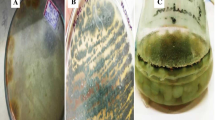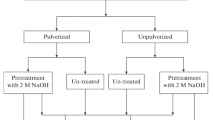Abstract
Electronic waste (E-Waste) is consumed at high speed in the world. These residues contain metals that increase their price each year, generating new research on the ability of microorganisms to recover the metals from these wastes. Therefore, this work evaluated the biologic lixiviation of Cu, Ag and Au from printed circuit boards (PCB) of mobile phones by three strains of Aspergillus niger, Candida orthopsilosis, Sphingomonas sp. and their respective consortia, in addition to leaching with citric acid. The microorganisms were cultured in mineral media with 0.5 g of PCB, and the treatments with 1M citric acid were added the same amount of PCB. All treatments were incubated for 35 days at room temperature. The results showed that Sphingomonas sp. MXB8 and the consortium of C. orthopsilosis MXL20 and A. niger MXPE6 can increase their dry biomass by 147% and 126%, respectively, in the presence of PCB. In the bioleaching of metals, the inoculation of A. niger MXPE6, the consortium of Sphingomonas sp. MXB8/C. orthopsilosis MXL20 and Sphingomonas sp. MXB8 leached 54%, 44.2% and 35.8% of Ag. The consortium of A. niger MX5 and A. niger MXPE6 showed a leaching of 0.53% of Au. A. niger MX5 leaching 2.8% Cu. Citric acid increased Cu leaching by 280% compared to treatments inoculated with microorganisms. Although further research is required, A. niger MXPE6 and the consortium of Sphingomonas sp. MXB8/C. orthopsilosis MXL20 could be an alternative to recover Ag from PCB of mobile phones.





Similar content being viewed by others
References
Águeda E, Garcia JL (2005) Automoción: elementos amovibles y fijos no estructurales. Thomson Paraninfo, Madrid
Andreazza R, Okeke BC, Pieniz S, Bortolon L, Lambais MR, Camargo FAO (2012) Effects of stimulation of sopper bioleaching on microbial community in vineyard soil and copper mining waste. Biol Trace Elem Res 146(1):124–133. https://doi.org/10.1007/s12011-011-9213-8
Anjum F, Bhatti HN, Asgher M, Shahid M (2010) Leaching of metal ions from black shale by organic acids produced by Aspergillus niger. Appl Clay Sci 47(3):356–361. https://doi.org/10.1016/j.clay.2009.11.052
Arshadi M, Mousavi SM (2015) Enhancement of simultaneous gold and copper extraction from computer printed circuit boards using Bacillus megaterium. Bioresour Technol 175:315–324. https://doi.org/10.1016/j.biortech.2014.10.083
Ban YH, Ahn JI, Sekhon SS, Cho SJ, Kim YH, Kim YC (2016) Identification of inducible proteins in the phenanthrene degrader Sphingobium chungbukense DJ77 by 2-dimentional electrophoresis and liquid chromatography/tandem mass spectrometry. Genes Genom 38(5):397–405. https://doi.org/10.1007/s13258-015-0374-2
Bastian P, Eichler W, Huber F, Jaufmann N, Manderla J, Spielvogel O, Springer G, Stricker F, Tkbtz K (2001) Electrotecnia, vol 1. Ediciones Akal, Madrid
Brandl H, Bosshard R, Wegmann M (2001) Computer-munching microbes: metal leaching from electronic scrap by bacteria and fungi. Hydrometallurgy 59(2):319–326. https://doi.org/10.1016/S0304-386X(00)00188-2
Brandl H, Lehmann S, Faramarzi MA, Martinelli D (2008) Biomobilization of silver, gold, and platinum from solid waste materials by HCN-forming microorganisms. Hydrometallurgy 94(1):14–17. https://doi.org/10.1016/j.hydromet.2008.05.016
Common MS, Stagl S (2008) Introducción a la economía ecológica. Reverté Barcelona, España;
Cui J, Zhang L (2008) Metallurgical recovery of metals from electronic waste: a review. J Hazard Mater 158(2):228–256. https://doi.org/10.1016/j.jhazmat.2008.02.001
Chen M, Huang J, Ogunseitan OA, Zhu N, Wang Y (2015) Comparative study on copper leaching from waste printed circuit boards by typical ionic liquid acids. Waste Manage 41:142–147. https://doi.org/10.1016/j.wasman.2015.03.037
Erust C, Akcil A, Bedelova Z, Anarbekov K, Baikonurova A, Tuncuk A (2016) Recovery of vanadium from spent catalysts of sulfuric acid plant by using inorganic and organic acids: laboratory and semi-pilot tests. Waste Manage 49:455–461. https://doi.org/10.1016/j.wasman.2015.12.002
Han DW, Lee MH, Lee MH, Uzawa M, Park JC (2005) The use of silver-coated ceramic beads for sterilization of Sphingomonas sp. in drinking mineral water. World J Microbiol Biotechnol 21(6):921–924. https://doi.org/10.1007/s11274-004-6721-0
He W, Li G, Ma X, Wang H, Huang J, Xu M, Huang C (2006) WEEE recovery strategies and the WEEE treatment status in China. J Hazard Mater 136(3):502–512. https://doi.org/10.1016/j.jhazmat.2006.04.060
Hocheng H, Hong T, Jadhav U (2014) Microbial leaching of waste solder for recovery of metal. Appl Biochem Biotechnol 173(1):193–204. https://doi.org/10.1007/s12010-014-0833-2
Hong Y, Valix M (2014) Bioleaching of electronic waste using acidophilic sulfur oxidising bacteria. J Clean Prod 65:465–472. https://doi.org/10.1016/j.jclepro.2013.08.043
Hoque ME, Philip OJ (2011) Biotechnological recovery of heavy metals from secondary sources—An overview. Mater Sci Eng 31(2):57–66
Ilyas S, Anwar MA, Niazi SB, Ghauri MA (2007) Bioleaching of metals from electronic scrap by moderately thermophilic acidophilic bacteria. Hydrometallurgy 88(1–4):180–188. https://doi.org/10.1016/j.hydromet.2007.04.007
Işıldar A, Van de Vossenberg J, Rene ER, van Hullebusch ED, Lens PNL (2016) Two-step bioleaching of copper and gold from discarded printed circuit boards (PCB). Waste Manage 57:149–157. https://doi.org/10.1016/j.wasman.2015.11.033
Kang HY, Schoenung JM (2005) Electronic waste recycling: a review of US infrastructure and technology options. Resour Conserv Recy 45(4):368–400
Kumar A, Saini HS, Kumar S (2018) Bioleaching of gold and silver from waste printed circuit boards by Pseudomonas balearica SAE1 isolated from an e-waste recycling facility. Curr Microbiol 75(2):194–201. https://doi.org/10.1007/s00284-017-1365-0
Lardé J, Ciudad JC, Rebolledo A, Picozzi A (2005) Situación y tendencias recientes del mercado del cobre. Recursos Naturales e Infraestructura
Madrigal-Arias JE, Argumedo-Delira R, Alarcón A, Mendoza-López MR, García-Barradas O, Cruz-Sánchez JS, Ferrera-Cerrato R, Jiménez-Fernández M (2015) Bioleaching of gold, copper and nickel from waste cellular phone PCBs and computer goldfinger motherboards by two Aspergillus niger strains. Braz J Microbiol 46(3):707–713. https://doi.org/10.1590/S1517-838246320140256
Mehta KD, Das C, Pandey BD (2010) Leaching of copper, nickel and cobalt from Indian Ocean manganese nodules by Aspergillus niger. Hydrometallurgy 105(1):89–95. https://doi.org/10.1016/j.hydromet.2010.08.002
Moustafa ESI (1999) Nonrenewable resources. In: Environmental geology. Encyclopedia of earth science. Springer, New York, pp 436–438
Natarajan G, Ting YP (2014) Pretreatment of e-waste and mutation of alkali-tolerant cyanogenic bacteria promote gold biorecovery. Bioresour Technol 152:80–85. https://doi.org/10.1016/j.biortech.2013.10.108
Natarajan G, Ting YP (2015) Gold biorecovery from e-waste: an improved strategy through spent medium leaching with pH modification. Chemosphere 136:232–238. https://doi.org/10.1016/j.chemosphere.2015.05.046
Ongondo FO, Williams ID, Cherrett TJ (2011) How are WEEE doing? A global review of the management of electrical and electronic wastes. Waste Manage 31(4):714–730. https://doi.org/10.1016/j.wasman.2010.10.023
Pant D, Joshi D, Upreti MK, Kotnala RK (2012) Chemical and biological extraction of metals present in E waste: a hybrid technology. Waste Manage 32(5):979–990. https://doi.org/10.1016/j.wasman.2011.12.002
Pradhan JK, Kumar S (2012) Metals bioleaching from electronic waste by Chromobacterium violaceum and Pseudomonads sp. Waste Manag Res 30(11):1151–1159. https://doi.org/10.1177/0734242x12437565
Qu Y, Li H, Tian W, Wang X, Wang X, Jia X, Shi B, Song G, Tang Y (2015) Leaching of valuable metals from red mud via batch and continuous processes by using fungi. Miner Eng 81:1–4. https://doi.org/10.1016/j.mineng.2015.07.022
Ren WX, Li PJ, Geng Y, Li XJ (2009) Biological leaching of heavy metals from a contaminated soil by Aspergillus niger. J Hazard Mater 167(1):164–169. https://doi.org/10.1016/j.jhazmat.2008.12.104
Robinson BH (2009) E-waste: an assessment of global production and environmental impacts. Sci Total Environ 408(2):183–191. https://doi.org/10.1016/j.scitotenv.2009.09.044
Saidan M, Brown B, Valix M (2012) Leaching of electronic waste using biometabolised acids. Chin J Chem Eng 20(3):530–534. https://doi.org/10.1016/S1004-9541(11)60215-2
Sambrook J, Rusell DW (2001) Molecular cloning: a laboratory manual, 3rd edn. Cold Spring Harbor Laboratory Press, New York pp. 7.4–7.8
Sayer JA, Gadd GM (2000) Binding of cobalt and zinc by organic acids and culture filtrates of Aspergillus niger grown in the absence or presence of insoluble cobalt or zinc phosphate. Mycol Res 105(10):1261–1267. https://doi.org/10.1017/S0953756201004749
SAS II (2017) The SAS system for windows, ver. 9.4. SAS Institute Inc, Cary
Vats MC, Singh SK (2015) Assessment of gold and silver in assorted mobile phone printed circuit boards (PCBs): Original article. Waste Manage 45:280–288. https://doi.org/10.1016/j.wasman.2015.06.002
Veit HM, Bernardes AM (2015) Electronic waste: generation and management. In: Viet HMB (ed) Electronic waste, recycling techniques. Springer, New York, pp 3–12. https://doi.org/10.1007/978-3-319-15714-6_2
Villas-Bôas RC, Sánchez M (2006) Tecnologías limpias en las industrias extractivas minero-metalúrgica y petrolera. Rio de Janeiro: CETEM/MCT/CNPq/CYTED/AECI:17–31
Weidenhamer JD, Clement ML (2007) Leaded electronic waste is a possible source material for lead-contaminated jewelry. Chemosphere 69(7):1111–1115. https://doi.org/10.1016/j.chemosphere.2007.04.023
Wilson KH, Blitchington RB, Greene RC (1990) Amplification of bacterial 16S ribosomal DNA with polymerase chain reaction. J Clin Microbiol 28(9):1942–1946
Wu BY, Chan YC, Middendorf A, Gu X, Zhong HW (2008) Assessment of toxicity potential of metallic elements in discarded electronics: a case study of mobile phones in China. J Environ Sci 20(11):1403–1408. https://doi.org/10.1016/S1001-0742(08)62240-8
Acknowledgements
Authors thank CONACYT for financial support provided by the research Grant CB-239601.
Author information
Authors and Affiliations
Corresponding author
Additional information
Publisher’s Note
Springer Nature remains neutral with regard to jurisdictional claims in published maps and institutional affiliations.
Rights and permissions
About this article
Cite this article
Díaz-Martínez, M.E., Argumedo-Delira, R., Sánchez-Viveros, G. et al. Microbial Bioleaching of Ag, Au and Cu from Printed Circuit Boards of Mobile Phones. Curr Microbiol 76, 536–544 (2019). https://doi.org/10.1007/s00284-019-01646-3
Received:
Accepted:
Published:
Issue Date:
DOI: https://doi.org/10.1007/s00284-019-01646-3




